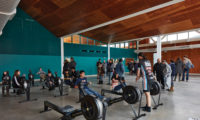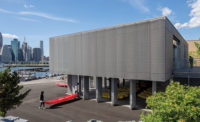Chicago
A rower crouches with her knees tucked below her fists, then dips her oars in the water and pulls back. The lines of the oars sketch an elegant V in the air, which is repeated over and over as the slender boat cuts through the water. Jeanne Gang thought about such movement when she started designing the WMS Boathouse at Clark Park in Chicago. She looked at Eadweard Muybridge's famous stop-motion photographs of rowers, eventually translating the dynamic lines of the oars into her building's distinctive sawtooth roofs and the exposed trusses that support them. The 22,600-square-foot boathouse, which cost $8.8 million to construct, continues to demonstrate Gang's interest in the Chicago River and her commitment to turning the much-abused waterway into a public amenity.
With the Muybridge photographs in mind, Gang designed a structural system for the Clark Park buildings' roofs that alternates between trusses shaped like inverted V's and ones shaped like M's. The steel trusses trace a rhythmic up-and-down pattern, which creates a jagged roof profile while framing clerestory glazing that brings southern light into the spaces below, warming the concrete floors. From the outside, the roofs are all sharp angles poking at the sky and grabbing attention. Inside, though, a softer geometry insinuates itself as the connective tissue between the bones. Look up at the ceiling and you notice that the large, 4-by-8-foot plywood panels overhead curve gently as they negotiate the distance between the V and M trusses. The subtle arc of these transitional planes calms the visual composition and at the same time sets off a wonderful rippling motion on the ceiling.
The boathouse is actually a pair of buildings: a one-story shed for storing rowing shells (as well as rental kayaks and canoes) and a two-story field house with a rowing tank, small offices for the Chicago Park District and the Chicago Rowing Foundation (CRF), a community room, and a space filled with ergometer exercise machines. Separating the functions in two buildings made sense because the boat storage area doesn't need to be heated or cooled, and a pair of structures could bracket a central plaza framing the view from the street to the river. The Park District was the client for the project, while CRF—a nonprofit that runs public programs for students and adults—is one of the main users.
Gang says that when she and her team started on the project, they tried applying oar-motion lines to the facades of the buildings. “It didn't work, so we used them for the roofs.” But the ghost of that initial idea can be seen in the faceted exterior walls of the two structures, which not only animate the elevations but offer views up and down the river to the people inside. A palette of rugged materials—slate shingles and zinc panels on the outside, plywood surfaces and concrete floors on the inside—emphasize the simple massing of the paired blocks. In the boat shed, teams of wet-suited rowers bring the space alive, lifting shells off black-steel racks in movements echoing those of the trusses.
Inside the field house, the architects cut loose in a couple of places: they specified colored tiles in the rest rooms that pick up the hues of the river (from brown to green) and painted a two-story wall in the lobby with a pattern of bright-orange life preservers on white drywall. Thoughtful touches include built-in seating on the stair landing and in the community room on the second floor, and a spacious balcony off the “erg” room that serves as an excellent place to watch races on the river.
Sustainable-design strategies were woven in throughout the project—from planting a pair of small “rain gardens” and using permeable concrete on the plaza (so no rainwater runs off the site) to providing enough daylighting to reduce dependence on electric fixtures.
Water is a theme that runs through many of Gang's projects. For an 82-story apartment tower in Chicago, she created rippling balconies that inspired its name: Aqua. And even a marble wall she designed for an exhibition at the National Building Museum cascaded out like a stream of stone. Her first boathouse on the Chicago River contributes to this record, converting athleticism into architecture.
People
Formal name of building:
Location:
Completion Date:
Gross square footage:
Total construction cost:
Client:
Owner:
Architect:
Personnel in architect's firm who should receive special credit:
Architect of record:
Engineers:
Consultant(s):
Other:
Photographer(s): Size: 22,620 feet Cost: $8.8 million (construction) Completion date: October 2013 |
Products
Exterior cladding
Roofing
Windows
Glazing
Doors
Hardware
Interior finishes
Furnishings
Lighting
Conveyance
Plumbing
Energy
Other unique products that contribute to sustainability: |














